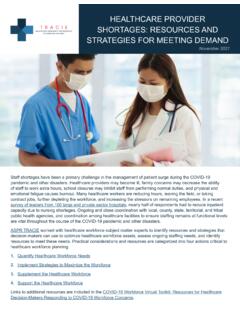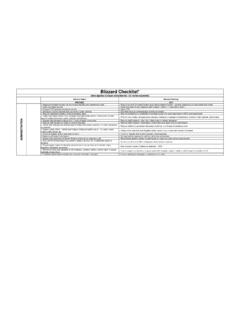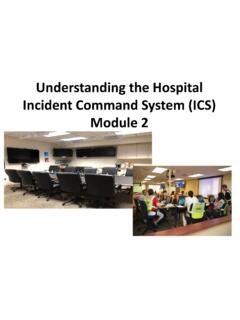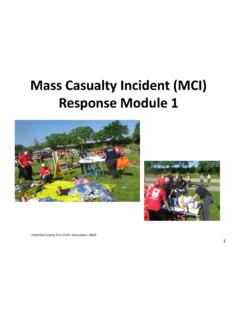Transcription of COVID-19: Healthcare Delivery Impacts
1 ~ --------- ----IJ 2stWave Im pact of resource ' restriction on urgent 1/ non- covid conditions 3rd Wave Impact of ..-interrupted care on t; chronic conditions Time 4th Wave Psychic trauma Mental illness Economic injury Burnout TRACI E covid -19 Healthcare Delivery Impacts Updated April 12, 2021 Introduction The covid -19 pandemic and the associated community mitigation efforts enacted have altered the Delivery of and access to Healthcare across the For example, emergency department (ED) visits are down by an estimated 40% in many communities across the country 1, 2; many in-person office visits have been either postponed by patient choice or changed to telehealth visits; elective procedures were delayed; and other types of Healthcare Delivery have been changed to accommodate social distancing and community mitigation measures.
2 Community mitigation actions, often driven by government orders and mandates, lead to a change in demand for traditional Healthcare services. This tip sheet can help Healthcare system planners understand and mitigate these potential Healthcare Delivery Impacts . NOTE: This document was originally published in 2020 and has been substantially updated and revised; information is current as of April 12, 2021. Guiding Concept This diagram was developed by Victor Tseng, MD, a pulmonology and critical care medicine fellow with the Department of Veterans Affairs. It depicts a potential series of Impacts and events that may affect the Healthcare system during subsequent waves of the covid -19 pandemic and was a guiding concept in developing this document. Source: Victor Tseng, MD 1 TRACIE H!
3 ,UTHC:AH !MUl(j.!li'C'f ~A{P'AHCN!SS INFOaMATION GATEWA't' Considerations Behavior Changes Leading to Long-Term Health Problems All disasters, including public health emergencies, can contribute to negative mental health effects, including stress. Behaviors that are used as coping mechanisms during times of increased stress may also have long-term Impacts on health. Following the September 11thattacks, a study found an approximate 3% increase in alcohol consumption among those who already consumed alcohol, a 21% increase in smoking among existing smokers, and a 1% increase in new At the start of the covid -19 outbreak, there was a slight increase (1%) in cigarette sales which fell over the subsequent weeks, possibly indicating Data reveals a 55% spike in alcohol sales for the week ending March 21, 2020 compared to previous weeks, again indicating possible stockpiling prior to staying at home.)}
4 Additionally, online wine and liquor Delivery sites reported an increase in orders; one company reported a 578% increase in new members with a increase in week-over-week , 6 Alcohol consumption appears to be leading to increased liver disease ,8, 9 As more people stay home, their level of physical activity may decrease, possibly contributing to an increase in diagnosis and treatment of high blood pressure, type 2 diabetes, coronary heart disease, anxiety, and Additionally, there is potential for an increase in childhood obesity as studies show children primarily gain weight during the summer months, when they are out of One survey of adults found that more than 40% gained weight (average gain was 29 pounds) since the pandemic ,13 People in recovery programs for substance abuse may experience relapse, as programs and meetings that took place before covid -19 may not be available due to social distancing.
5 Stay home orders may also contribute to a feeling of isolation, one risk factor of Similar to other applications, use of telehealth in treating addiction, such as for opioid use, has advanced quickly in response to Potential Mitigation Strategies Providers could consider patient education ( , email blasts, mailers, free media) about safe coping mechanisms during the pandemic. Providers should ensure they ask patients about these behaviors and provide patient education about safe coping mechanisms during patient visits held during covid -19. Concurrent or Secondary Disasters during the covid -19 Pandemic The mitigation measures necessary to protect the population from spread of covid -19 make certain secondary disasters much more impactful on disaster affected communities.
6 Disasters involving the need for evacuation and community or congregate sheltering, for instance, are much more significant and logistically challenging when physical distance is necessary to prevent disease spread. In the past year, wildfires, hurricanes, and winter storms impacted Healthcare access and Delivery during covid . Winter storms disrupted mass vaccine efforts. Shelters struggled to maintain disease prevention 2 TRACIE H!,UTHC:AH !MUl(j.!li'C'f ~A{P'AHCN!SS INFOaMATION GATEWA't' strategies as crowding increased amid winter temperatures. Wildfire smoke caused symptoms similar to covid -19. In addition, increased dependency on technology for telemedicine/telehealth and remote work during the pandemic have brought cybersecurity issues to the forefront of Healthcare operations, impacting patient care and safety.)}
7 Cyber attacks against Healthcare facilities have increased by 9851% over the course of 2019 into Attacks increased throughout 2020, with a peak in the September and October timeframe, and over the course of 2020, over one million Healthcare records were breached per Potential Mitigation Strategies Review guidance on shelter operations during covid -19 and work with community leaders prior to bad weather to identify alternative housing in disaster prone areas. Begin planning for summer heat conditions and the 2021 hurricane season. Related ASPR TRACIE resources o Secondary Disasters During covid -19 o Healthcare System Cybersecurity: Readiness and Response Considerations Continued Disruption of the Supply Chain Even if covid -19 transmission has been reduced in the community and facilities have the space and staffing to support additional patient care, supplies and resources may not be ,19 The supply chains for personal protective equipment (PPE), some medications, medical supplies and equipment, and disinfection and hygiene products have been stressed by increased Due to the ongoing pandemic, some supply lines may continue to experience critical shortfalls.
8 Social distancing guidelines, travel restrictions, and staffing shortages have further reduced or delayed the availability of some resources. Many ambulatory care providers donated their supplies to hospitals or long-term care facilities in the beginning of the pandemic and then needed to purchase new supplies before being able to reopen. The lack of a predictable supply chain for essential materiel may interfere with the ability of some providers to remain open or offer certain procedures and may remain a longer-term problem for Healthcare facilities. Additional complications arose over the past year, including: An increase in fraudulent medical ,22 A shortage in dry ice due to the unique cold storage requirements of some vaccines23 Fewer donations have contributed to critical shortages in the nation s blood supply.
9 24,25 Potential Mitigation Strategies Carefully track use of critical supplies. Switch away from just-in-time inventory. Pre-order and pre-purchase whenever possible. Collaborate with other Healthcare facilities for larger purchase power. Implement conservation and optimization strategies. ( , understand utilization rates, establish par levels and distributions points). 3 TRACIE H!,UTHC:AH !MUl(j.!li'C'f ~A{P'AHCN!SS INFOaMATION GATEWA't' Utilize available federal funding to purchase supplies, where eligible. Decreased ED Visits/Patients Delaying Emergency Care While EDs across the country are treating covid -19 or suspected covid -19 patients, the number of patients seeking emergency care for other chief complaints has ,27,28 This trend is not new.)}
10 A decrease in utilization of Healthcare also occurred (in affected areas) during the 2003 Severe Acute Respiratory Syndrome outbreak, the 2014 West Africa Ebola outbreak, and the 2015 Middle Eastern Respiratory Syndrome (MERS-CoV) outbreak. For example, during the 2015 MERS-CoV outbreak in South Korea, ED visits decreased on average around 33% compared to visits in June 2014 and 2016. The number of low-acuity patients visiting EDs also decreased; visits for ear infections, for example, fell by 53%. High-acuity patient visits also decreased on a smaller scale with visits for heart attacks and strokes declining by 14% and respectively, but in 2021, higher acuity patients are continuing to present to the ,30,31 It should be noted that some of these decreases could also be attributed to use of telehealth or trained emergency medical services personnel to pre-screen patients before arriving at the , 33 Anecdotal evidence suggests that patients are also waiting to seek all types of treatment.









